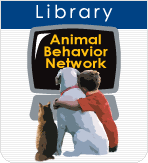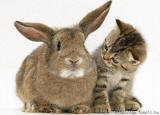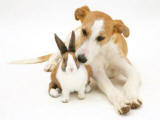|
Need Help?
|
|
Call
1-800-372-3706
to
speak to a Veterinary Behavior Technician |
|
Paws To Speak!
Member
Main Menu
|
 |
|
Help is at your
fingertips by library, email and
phone. |








|

Getting along with others is a critical skill that all Pets need to learn. Your new Pet will need to learn how to properly greet new people and pets in multiple situations before it can be friends with them. Managing new relationships right from the start will help your Pet learn a critical life skill! How your Pet reacts to new Pets and people will help you determine if you will be able to introduce additional Pets into your household or have play dates with friends.
Meeting New People
We've all been here. Whether we are in our front yard, have a visitor at the door, or a
have a handyman fixing the sink, our goal is to teach your Pet that new people are great to be around! Watch your Pet's body language carefully to determine if they are excited, happy, fearful, or aggressive.
Rabbits can be shy and skittish, or outgoing and friendly, it just depends on the rabbit. Do not force your rabbit upon someone new in the home. If your Pet runs and hides, do not attempt to pull
them out from their pen, scold, or punish. As your Pet becomes accustomed to seeing and hearing new people, curiosity typically takes over and your rabbit will slowly venture out to see what is going on. Have new people sit quietly and offer your Pet a high valued treat. Encourage relaxed behavior of your guest and allow your rabbit time to get used to them. Negative experiences with visitors can be extremely detrimental to the socialization of your Pet so be very careful
to make sure your rabbit is never teased or mistreated.
Remember, be patient! Over time, interactions between your Pet and new People will help increase your rabbit's comfort level and confidence leading to a social Pet.
 Reward your Pet for no reaction with treats and praise. Carry treats with you and encourage good behavior. Remember, learning to trust others takes time so dozens of encounters may be needed over a period of weeks or months. Be Patient! Reward your Pet for no reaction with treats and praise. Carry treats with you and encourage good behavior. Remember, learning to trust others takes time so dozens of encounters may be needed over a period of weeks or months. Be Patient!
Increasing Valued Resources
Your new Pet will quickly learn that you are the giver of all things good. Resources are defined as anything your rabbit thinks is good or important. Treats, a soft bed, lavish praise, petting, toys, playtime, and going outside are all examples of resources which the leader (YOU!) controls.
Rabbits are easily bored so it is important to provide plenty of resources which are mentally stimulating. Interactive toys, food puzzles, chew posts, hiding places, elevated platforms, and play time with you are all excellent ways to stimulate your Pet.
Defining Territory
Rabbits are territorial creatures unbeknown to most! When you see your rabbit rubbing his chin against you and different objects they are leaving a scent to figure out where they have been and whether or not this is their territory.
Of course, the more comfortable your rabbit is, the more likely it is to mark its territory with urine and feces. It is very important to constantly supervise your Pet so you don't end up with a mess everywhere. Over time your rabbit will learn where it is acceptable to eliminate.
Establishing Positive Interactions
Rabbits can become accepted members of an already established household with other pets but it takes time and careful supervision.
Begin by housing your new Pet in a separate room away from other household members. Place a t-shirt or other piece of fabric near the cage where they can't chew it but where the scent of your rabbit can be picked up. Place another t-shirt or piece of fabric where your other Pet sleeps.
Allow your established Pets to smell the fabric of your rabbit. This will help them become accustomed to the smell of your new Pet. Do the same while holding your rabbit and letting them sniff the fabric from your other pets.
Introductions must be made slowly and careful. Never allow a negative experience to occur between your rabbits and other family pets. Rabbits are fragile and injury or even death can be caused inadvertently without constant supervision.
Never leave your rabbit alone with any other household Pet. Even if you believe them to be trustworthy. Supervise! Supervise! Supervise!
Jolly Routine
The Jolly Routine is a method coined by the renowned behaviorist, William Campbell. The Jolly Routine means the Pet parent is happy, relaxed, or "jolly". The Jolly Routine can be used anytime your Pet encounters a tense situation. Thunderstorms, fireworks, a trip to the veterinarian, strangers, or other scary or anxiety inducing situations all call for a Jolly Routine. The goal is to show your Pet that you are happy and gleeful and not upset about what is going on around them. Your Pet will look to you for leadership and they can sense from you how they should be feeling.
|